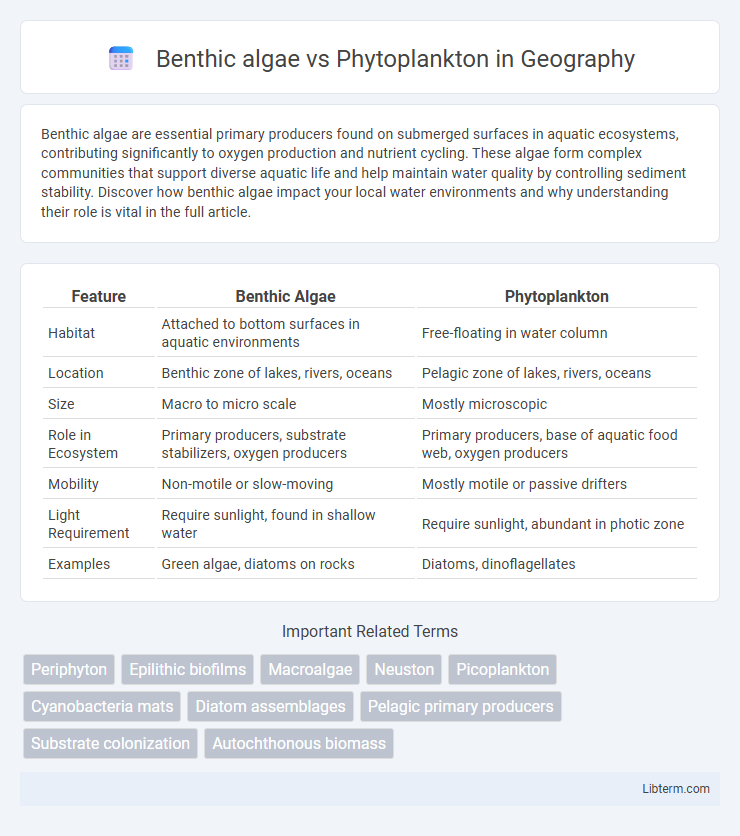Benthic algae are essential primary producers found on submerged surfaces in aquatic ecosystems, contributing significantly to oxygen production and nutrient cycling. These algae form complex communities that support diverse aquatic life and help maintain water quality by controlling sediment stability. Discover how benthic algae impact your local water environments and why understanding their role is vital in the full article.
Table of Comparison
| Feature | Benthic Algae | Phytoplankton |
|---|---|---|
| Habitat | Attached to bottom surfaces in aquatic environments | Free-floating in water column |
| Location | Benthic zone of lakes, rivers, oceans | Pelagic zone of lakes, rivers, oceans |
| Size | Macro to micro scale | Mostly microscopic |
| Role in Ecosystem | Primary producers, substrate stabilizers, oxygen producers | Primary producers, base of aquatic food web, oxygen producers |
| Mobility | Non-motile or slow-moving | Mostly motile or passive drifters |
| Light Requirement | Require sunlight, found in shallow water | Require sunlight, abundant in photic zone |
| Examples | Green algae, diatoms on rocks | Diatoms, dinoflagellates |
Understanding Benthic Algae and Phytoplankton
Benthic algae are photosynthetic organisms that grow attached to underwater surfaces such as rocks, sediments, or plants in aquatic ecosystems, playing a crucial role in nutrient cycling and habitat formation. Phytoplankton are microscopic, free-floating photosynthetic organisms found in the pelagic zone of oceans, lakes, and rivers, serving as the foundation of aquatic food webs and vital oxygen producers. Understanding the distinct ecological niches, growth conditions, and contributions of benthic algae and phytoplankton is essential for accurately assessing aquatic ecosystem health and primary productivity.
Key Differences in Habitat and Distribution
Benthic algae primarily inhabit the bottom surfaces of aquatic environments, attaching to rocks, sediments, or submerged plants in freshwater and marine ecosystems. Phytoplankton are free-floating microscopic organisms that thrive in the open water column, often found near the surface where sunlight is abundant. The distinct habitat preferences result in benthic algae contributing to substrate-level primary production, while phytoplankton play a critical role in pelagic food webs and global carbon cycling.
Morphological Distinctions
Benthic algae exhibit filamentous or mat-like structures anchored to substrates, contrasting with the predominantly unicellular and free-floating forms of phytoplankton. Morphological adaptations in benthic algae include holdfasts and robust cell walls facilitating attachment and resistance to water currents. Phytoplankton morphology ranges from spherical to elongated shapes optimized for buoyancy and light capture in pelagic environments.
Primary Roles in Aquatic Ecosystems
Benthic algae and phytoplankton both serve as primary producers in aquatic ecosystems, converting sunlight into energy through photosynthesis and forming the base of the food web. Benthic algae primarily inhabit substrates like rocks and sediments in shallow waters, contributing to nutrient cycling and providing habitat structure for benthic organisms. Phytoplankton, suspended in the water column, drive oxygen production and form a crucial food source for zooplankton and higher trophic levels in open water environments.
Photosynthetic Strategies and Light Adaptation
Benthic algae utilize specialized pigments and photosynthetic pathways to optimize light absorption in low-light, substrate-attached environments, often displaying increased pigment diversity and higher efficiency under shaded or turbid conditions compared to phytoplankton. Phytoplankton primarily rely on accessory pigments like chlorophyll a, c, and carotenoids to capture light efficiently in the water column, adapting to dynamic light conditions through rapid acclimation and vertical migration to maintain optimal photosynthesis. Both groups employ state transitions and non-photochemical quenching mechanisms to manage excess light energy and minimize photodamage, yet benthic algae's adaptations favor stable, benthic microhabitats while phytoplankton exhibit flexible responses to fluctuating pelagic light environments.
Nutrient Uptake and Growth Patterns
Benthic algae exhibit nutrient uptake primarily through direct absorption from sediment and surrounding water, optimizing growth in nutrient-rich, stable environments with lower light penetration. Phytoplankton absorb nutrients dissolved in the water column, displaying rapid growth patterns influenced by water turbulence and light availability, often leading to blooms in nutrient-abundant conditions. Variations in nutrient uptake mechanisms and growth rates between benthic algae and phytoplankton significantly impact aquatic ecosystem productivity and nutrient cycling.
Ecological Interactions and Food Web Contributions
Benthic algae, found attached to substrates in aquatic environments, provide critical habitat and primary production that supports diverse invertebrate communities, forming the base of complex benthic food webs. Phytoplankton, suspended in the water column, drive pelagic ecosystems through rapid photosynthesis, serving as a primary food source for zooplankton and higher trophic levels like fish. Both groups contribute to nutrient cycling and energy flow, with benthic algae influencing sediment stability and phytoplankton regulating oxygen dynamics in aquatic habitats.
Impact on Water Quality
Benthic algae contribute to water quality by stabilizing sediment and cycling nutrients at the bottom of aquatic ecosystems, often enhancing oxygen levels through photosynthesis. Phytoplankton, suspended in the water column, play a crucial role in primary production but can cause harmful algal blooms that deplete oxygen and release toxins, negatively affecting water quality. Both benthic algae and phytoplankton influence nutrient dynamics and oxygen availability, shaping the overall health and clarity of water bodies.
Human Influences and Environmental Concerns
Human activities such as nutrient runoff from agriculture and wastewater discharge have led to eutrophication, promoting excessive growth of both benthic algae and phytoplankton, which disrupt aquatic ecosystems. Phytoplankton blooms often result in hypoxic conditions harmful to marine life, while overgrowth of benthic algae can smother coral reefs and reduce biodiversity. Monitoring and managing nutrient inputs remain critical to mitigating these environmental concerns and preserving water quality.
Summary of Benthic Algae vs Phytoplankton
Benthic algae are photosynthetic organisms that inhabit the bottom surfaces of aquatic environments, playing a vital role in nutrient cycling and providing habitat for various microorganisms and invertebrates. Phytoplankton are microscopic, free-floating photosynthetic organisms found in the water column, forming the base of aquatic food webs and significantly contributing to global oxygen production. While benthic algae anchor to substrates and influence sediment stability, phytoplankton drive primary productivity in open water and support higher trophic levels in marine and freshwater ecosystems.
Benthic algae Infographic

 libterm.com
libterm.com